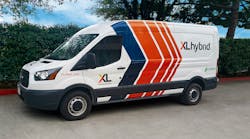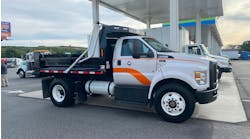Bridging the gap with hybrid battery electric technologies
As more fleets opt to go electric, there are instances where testing out the technology by way of hybrids makes sense.
The vehicle electrification company XL has worked with vehicle manufacturers Ford and General Motors to upfit hybrid battery systems onto traditional internal combustion engine Class 2 through 6 commercial vehicles.
“Fleets have very strong preferences, for obvious reasons, on the types of vehicles they use, types of performance they require for their vehicles,” says Eric Foellmer, director of marketing for XL. “We’re not trying to make our own trucks that would mirror those performance characteristics. What we do is turn those great trucks into hybrid vehicles.”
With XL vehicles, the fleet gains the benefits of having an electric battery system, but there is no range anxiety because the vehicle’s factory-installed internal combustion engine is still equipped on the vehicle.
The XL system provides an acceleration assist that allows the vehicle to utilize the electric motor to accelerate the vehicle from the stop or at low speeds, traditionally when fuel is most needed during vehicle operation, to improve fuel efficiency and reduce emissions.
Real-world use
Calvin Jones works as the chief equipment manager for the Montgomery County Division of Fleet Management Equipment Maintenance & Transit Operation Center, located in Derwood, Maryland. Montgomery County has worked with XL since 2013, and has 30 XL hybrid vehicles in their fleet.
“We had a good sub-fleet to use with a favorable profile we felt would work well with hybridization,” Jones explains. “Another factor was that the fact that the state of Maryland has a grant voucher program which pays for up to 50 percent of the system.”
When it comes to maintenance, Foellmer says a proprietary telematics system called XL Link provides alerts to continuously monitor the condition of the vehicle and its various systems. When there is an issue, XL’s maintenance team receives an alert, they review the incident and will notify the fleet if the fleet needs to take action.
“We monitor the service requirements and work with our customers proactively to make sure the system is maintained and performing optimally at all times,” Foellmer says.
“The reason we continued to buy more of them was we really enjoyed the telematics function, it’s a very reliable system,” Jones says. “We’ve had very few failures or faults associated with the system. We’re (also) seeing a 21 percent increase in fuel economy.”
In terms of maintenance, Jones confirms they did not modify the preventative maintenance program for these particular vehicles. After evaluation, Jones notes the frequency of some wear items such as brake pads has decreased. He also advises they did not alter the oil change intervals.
Foellmer adds that OEM factory warranties and maintenance schedules would still apply. “We don’t impact or affect those in any way,” he says.
Jones confirms the fleet anticipates expanding the spec’ing of XL vehicles by testing out the company’s plug-in hybrid electric pickup truck technology.
“We’re working with the Department of Corrections," Jones says. "We wanted to do some perimeter vehicles, because they needed a four-wheel drive vehicle that had electrification. They did not need the bed space for cargo. We plan on specifying those with that system.”




